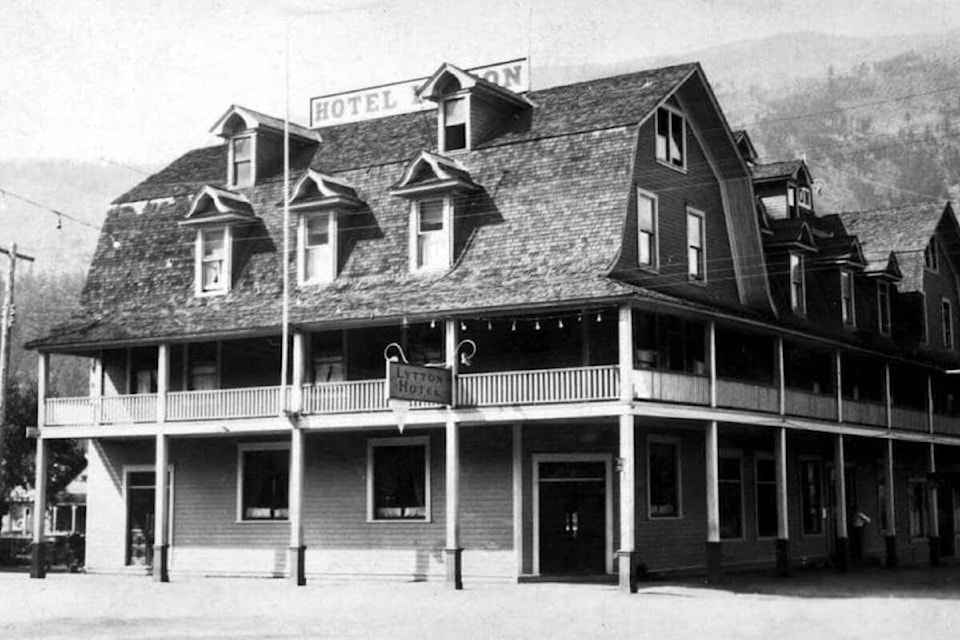~BW Uzelman
Lytton had a storied past, long before the catastrophic fire of June 30, 2021. The community was founded in 1858 when buildings from a nearby HBC post, Fort Dallas, were moved to present village site at the confluence of the Thompson and Fraser Rivers. Lytton, almost immediately, began to serve and be served by the superhighway of the day, the Cariboo Road.
Many eons before, indigenous people had begun to inhabit the site. Barbara Roden, mayor of Ashcroft, wrote, the site, ŌĆ£has long been considered the heart of the NlakaŌĆÖpamux territory.ŌĆØ She notes, ŌĆ£Bruce Hutchison [BC author and journalist] wrote that the site is, ŌĆśan ancient town, more ancient than any built by white men in America.ŌĆÖŌĆØ Roden highlights an 1858 quote of celebrated Chief CexpeŌĆÖnthlEm, ŌĆ£At Lytton is my center-post. It is the middle of my house and I sit there.ŌĆØ He evidently was expressing a deep bond to Lytton as his home, and perhaps a spiritual attachment to the land of his people.
The fire of 2021 obliterated Lytton. Now, though, progress has been made toward reconstruction. Ninety percent of the village was destroyed, including most of the business area. Both the provincial and federal governments have allotted funds for the restoration of the community.
Denise OŌĆÖConnor, mayor of the village, told a Kamloops radio station in January that work on debris removal and soil remediation continues. Once cleanup is complete, reconstruction can begin, maybe in March or April. She hopes that construction of the municipal buildings, including the village office, the public works building and the fire hall, along with businesses and homes, will accelerate through 2023.
Back in the 1860ŌĆÖs, steam ships plied the Fraser from its mouth to Yale, the head of navigation. The Caribou Road was constructed from Yale to Lytton and beyond in 1862-1863 and to Barkerville in 1864-1865. The road, a marvel of the time, clung to the mountain sides through the perilous Fraser Canyon. The road was blasted out of the rock. Log structures supported the road base beyond the rocky edge.
The Cariboo Road offered a relatively safe route for the freight wagons and stagecoaches and the miners and townspeople of the Cariboo. Lytton responded; it served the travelers and the miners. The Hautier family, in 1862, opened the first of several iterations of the Globe Hotel. The settlement thrived through most of the 1860ŌĆÖs, but growth stagnated late in the decade. In the 1880ŌĆÖs the first of the railroads, the CPR, pushed through Lytton. Then, the Canadian Northern Railway arrived. It was subsequently absorbed by the CNR. The railroads brought renewed activity and growth to the towns on the lines.
Lytton prospered to the end of the 19th century and through the early decades of the 20th century, according to Bill Barlee, BC historian. The steady payroll of the railroads, the traffic on the Caribou Road and the mining and ranching in the area fed the local economy. A second major hotel was built in 1912, the large four-story Lytton Hotel, while the Globe Hotel, in its fourth incarnation, continued to operate.
Late in 2022, Lytton launched its Economic Recovery Plan ŌĆ£to facilitate and present meaningful ground-up solutions to support Lytton and Regions Economic Recovery.ŌĆØ The final report is due in March. The village notes the new ŌĆ£Building By-Law 711 will improve the communityŌĆÖs resistance to inevitable future wildfires.ŌĆØ Lytton is to become the first community in Canada to adopt the National Guide for Wildland-Urban Interface Fires. These efforts are essential for the villageŌĆÖs viability after the disaster of 2021.
The fire of 2021, though, was not the first in Lytton. In 1931, a fire began in the Lytton Hotel, reduced it to ash and spread through the business district, consuming two large blocks. And in 1938, fire destroyed the historic Globe Hotel and several other businesses. At the same time, the Great Depression devastated small towns across the country, including Lytton. In 1949, again, many businesses and homes in the downtown were levelled by fire.
ŌĆ£Lytton really lost ŌĆō I think it lost its heart in the 1931 fire. ŌĆ” Lytton never really recovered,ŌĆØ said Barlee. ŌĆ£In that space of 18 years [1931-1949] ŌĆ” Lytton ceased to be the old Lytton. ŌĆ” The old buildings that were there, ŌĆ” the style and the character and the mood of this town virtually vanished with these three fires.ŌĆØ But Barlee believed that Lytton retained its history, and it retained its key geographic location at the confluence of the two great rivers, where once stood the ancient indigenous village and the old fort. ŌĆ£Lytton has a magnificent history, and of course both rivers have a magnificent history.ŌĆØ
That history remains with Lytton; itŌĆÖs intrinsic. But the former residents, and prospective new residents, still face a huge task to reconstruct their houses and businesses and to recreate community and home.

Bruce W Uzelman
I grew up in Paradise Hill, a village in Northwestern Saskatchewan. I come from a large family. My parents instilled good values, but yet afforded us, my seven siblings and I, much freedom to do the things we wished to do. I spent my early years exploring the hills and forests and fields surrounding the village, a great way to come of age.
I attended the University of Saskatchewan in Saskatoon. I considered studying journalism at one point, but did not ultimately pursue that. However, I obtained a Bachelor of Arts, Advanced with majors in Economics and Political Science in 1982.
Contact: urbangeneral@shaw.ca
Like us on and follow us on .



